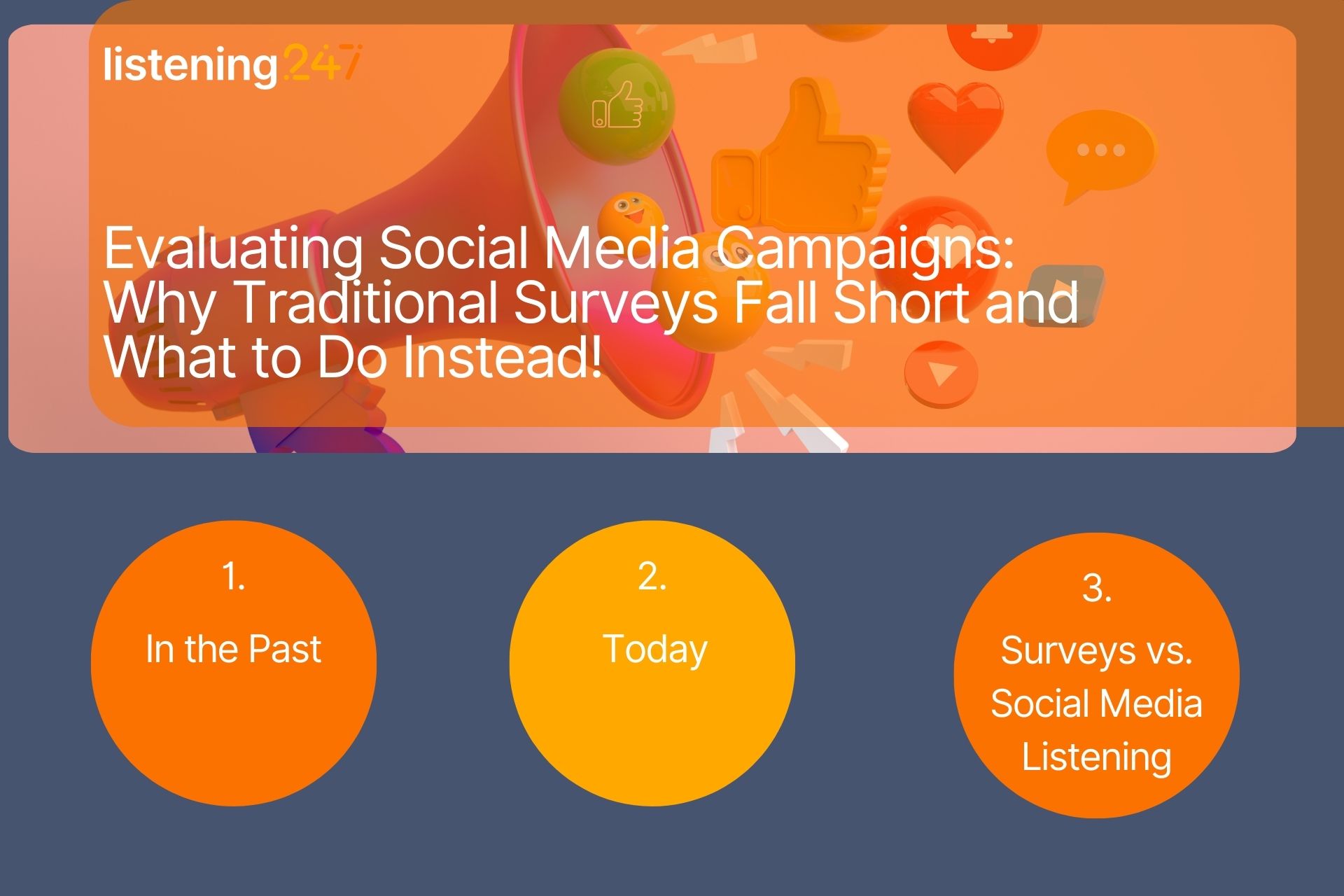
Blog Post
Evaluating Social Media Campaigns: Why Traditional Surveys Fall Short and What to Do Instead!

Social media for over a decade now have established themselves as a powerful tool for marketers to reach out to their target audience and promote their brands. With the rise of social media platforms such as Facebook, Twitter, Instagram, YouTube, Reddit and TikTok businesses have found new ways to reach out to their customers. However, the success of social media campaigns can be difficult to measure. In this post, we will discuss the best way of evaluating the performance of social media campaigns.
In the Past
Traditionally, brands have used tracking surveys to evaluate frequent campaigns. For ad-hoc campaigns these surveys were conducted before and after to measure changes in brand awareness, perception, and loyalty. While these methods can be useful, they are time-consuming and expensive. Moreover, it can only provide a limited understanding of the impact of a campaign.
One of the main limitations of using surveys for evaluating social media campaigns is that they are based on a sample of respondents. In other words, only a small group of people are asked to provide feedback on the campaign. Some of them agree and some don’t. This can lead to biased results and make it difficult to draw meaningful conclusions about the campaign's impact on the broader population.
Today
In contrast, social media listening and analytics allows for a more comprehensive analysis of the campaign's impact. This method involves monitoring all the posts and mentions related to the campaign, rather than relying on a small sample of respondents. This provides a more accurate and representative view of how the campaign is being received by the public.
Social media listening involves monitoring social media platforms for mentions of a brand, product, or service. This method can provide real-time feedback on the effectiveness of a campaign. Machine learning for text analytics, on the other hand, can help analyse large volumes of data and identify patterns and insights that would be difficult to detect manually.
One of the most effective ways of evaluating social media campaigns is by tracking engagement metrics. Engagement metrics include likes, comments, shares, and clicks. By monitoring these metrics, brands can determine how well their content is resonating with their target audience. Moreover, engagement metrics can help brands identify which platforms and types of content are most effective for their audience.
Another important metric to track is conversions. Conversions refer to the number of people who take a desired action, such as making a purchase, after seeing a social media post. By tracking conversions, brands can determine the ROI of their social media campaigns.
Furthermore, social media listening and analytics can help brands identify patterns and insights that would be difficult to detect through traditional surveys. Machine learning algorithms can analyse large volumes of data and identify trends and themes that may be missed by manual analysis. For example, sentiment analysis can help brands identify whether the overall tone of the conversation about their campaign is positive, negative, or neutral, and adjust accordingly.
It is important to measure the reach of social media campaigns. Reach refers to the number of people who have seen a post. By tracking reach, brands can determine how far their message is spreading and identify opportunities for growth.
Finally, social media listening and analytics can be more cost-effective than traditional surveys. While surveys can be time-consuming and expensive to conduct, social media listening and analytics tools are often more affordable and accessible. This makes it easier also for smaller companies to monitor their campaigns and make data-driven decisions.
Surveys vs. Social Media Listening
Surveys and social media listening produce different metrics for evaluating social media campaigns. While surveys can provide valuable insights into how customers perceive a brand, social media listening can offer a more comprehensive and real-time view of a campaign's impact. Here's a comparison of some key campaign evaluation metrics produced by surveys versus social media listening:
- 1. Awareness vs. Reach: Surveys typically measure brand awareness before and after a campaign, whereas social media listening can track the reach of a campaign in real-time. While surveys can provide a snapshot of a campaign's impact on brand awareness, social media listening can offer a more accurate and up-to-date view of how many people are seeing and engaging with a campaign.
- 2. Likeability vs. Sentiment: Surveys can measure how much customers like a campaign, whereas social media listening can track sentiment to determine whether the overall tone of social media posts related to a campaign is positive, negative, or neutral. While likeability is important, sentiment can provide a more nuanced view of how a campaign is being received and can help brands identify potential issues or opportunities.
- 3. Declared Engagement vs. Actual Engagement: Surveys can ask customers about their engagement with a campaign, whereas social media listening can track actual engagement metrics such as likes, comments, shares, and clicks. While declared engagement can provide some insights into how customers perceive a campaign, actual engagement metrics can offer a more accurate and comprehensive view of how customers are interacting with a campaign.
- 4. Purchase Intent vs. Actual Purchase: Surveys can measure customers' purchase intent or declared purchases, while social media listening can track actual purchase behaviour through conversion metrics. While declared purchase intent can provide some insights into customers' likelihood to purchase a product or service, conversion metrics can provide a more accurate and concrete view of whether a campaign is driving sales.
My usual stance is that social media listening, or the practice of monitoring unsolicited customer opinions, can serve to enhance and complement survey results, which rely on solicited customer opinions. However, there are instances where I strongly believe that surveys are not the most effective way to gather feedback. For example, when assessing the impact of an advertisement on social media, it doesn't make sense to rely solely on a small group of survey participants who agreed to give their opinion for a fee. Instead, we can leverage social media listening to gain insights from all the individuals who actually saw the ad online and freely expressed their thoughts about it. By doing so, we can obtain a more accurate and comprehensive understanding of the ad's reception among the target audience.
Conclusion
While traditional methods of evaluating social media campaigns can still be somewhat useful, there are now more effective and efficient ways to measure performance. Social media listening and machine learning for text analytics have made it easier to track engagement, conversions, sentiment, and reach. This method provides a more comprehensive analysis of the campaign's impact, allows for real-time feedback, and can be more cost-effective. By using these metrics, brands can gain a better understanding of the impact of their campaigns and make data-driven decisions to improve their brand strategies.
“You don’t have to be a major multinational brand to be able to afford social media listening, as a matter of fact such an approach is way cheaper than the traditional one.”